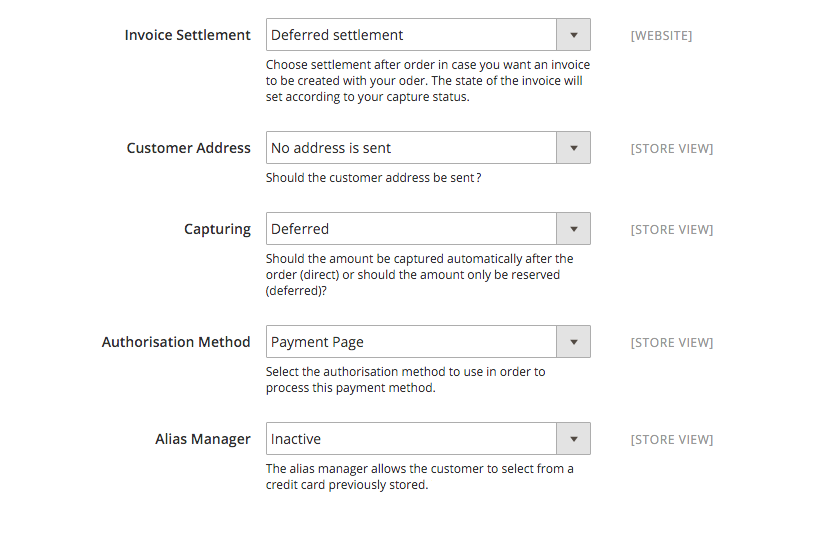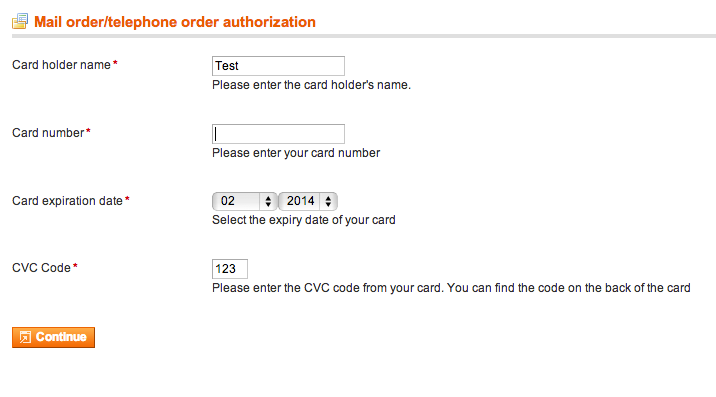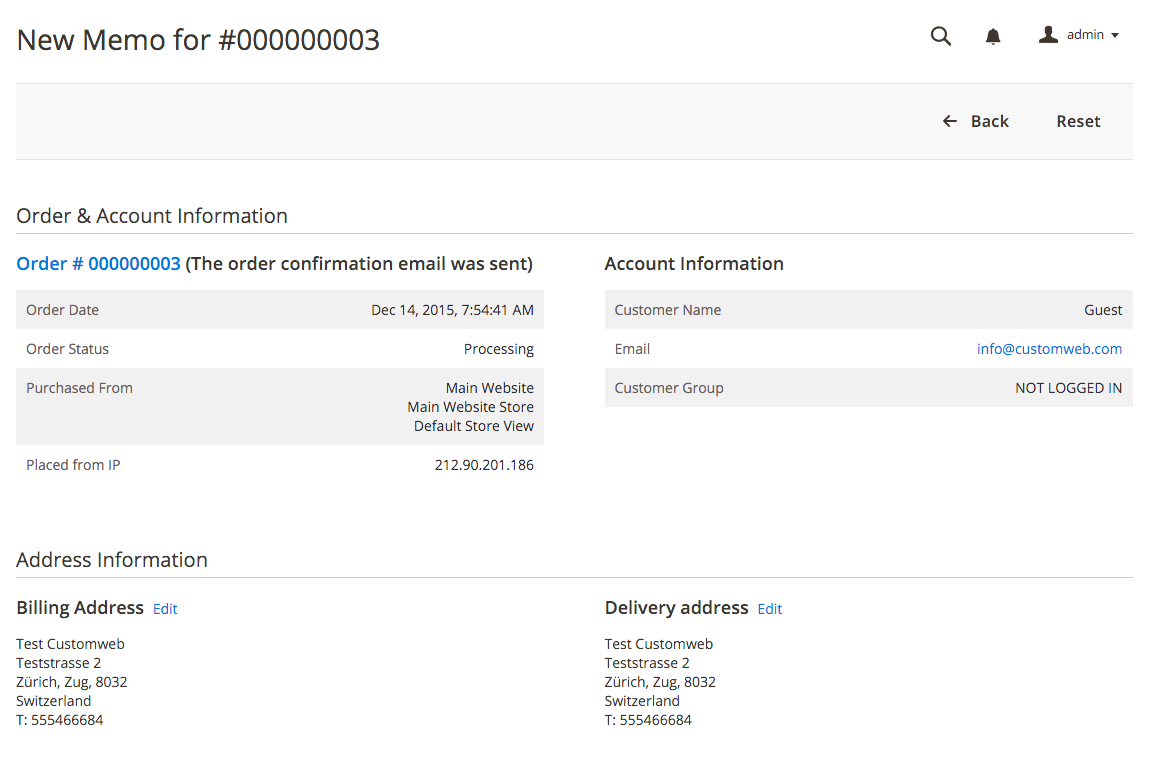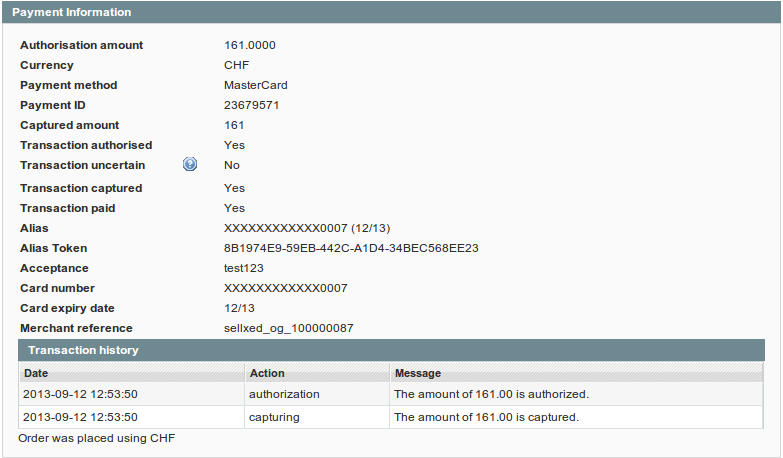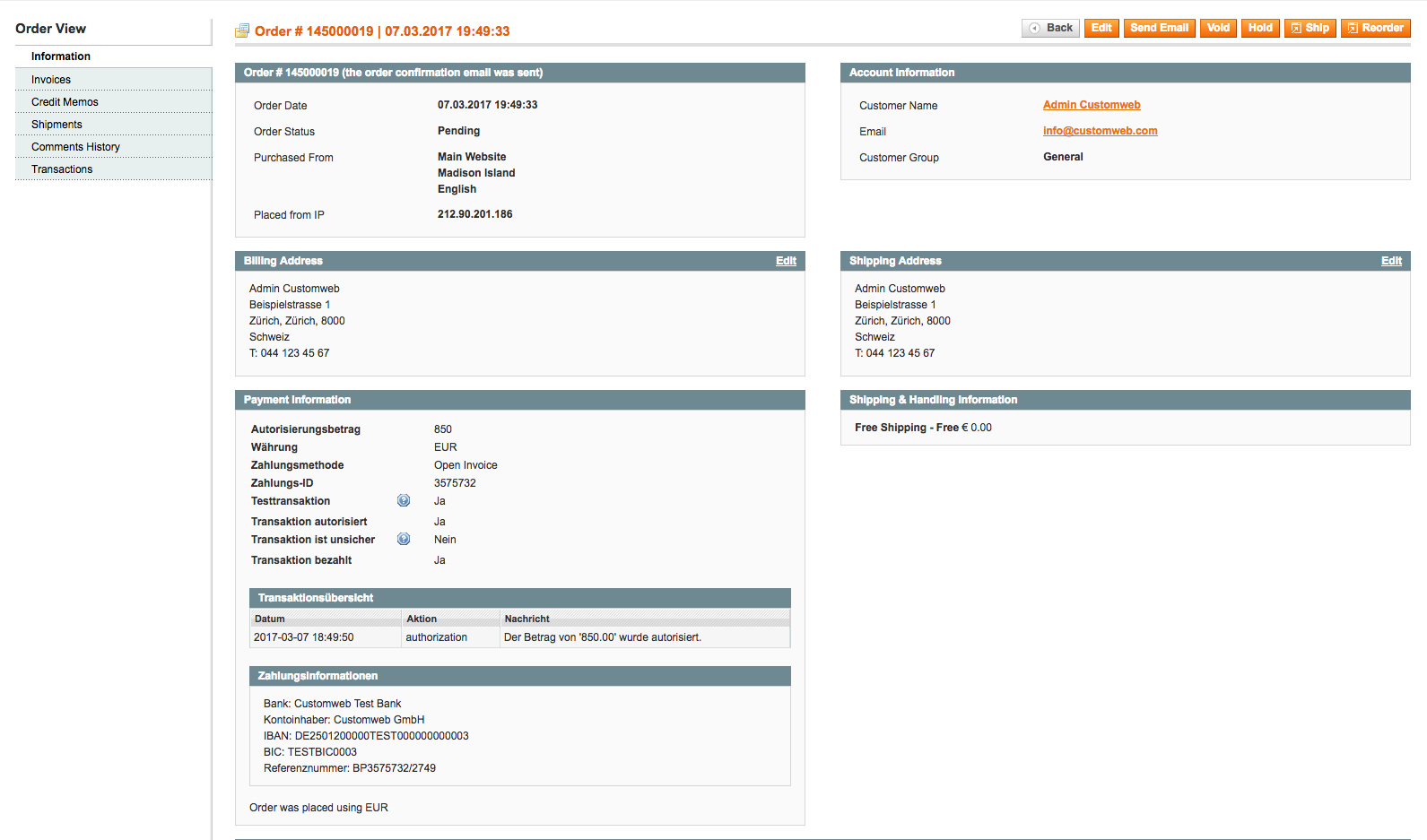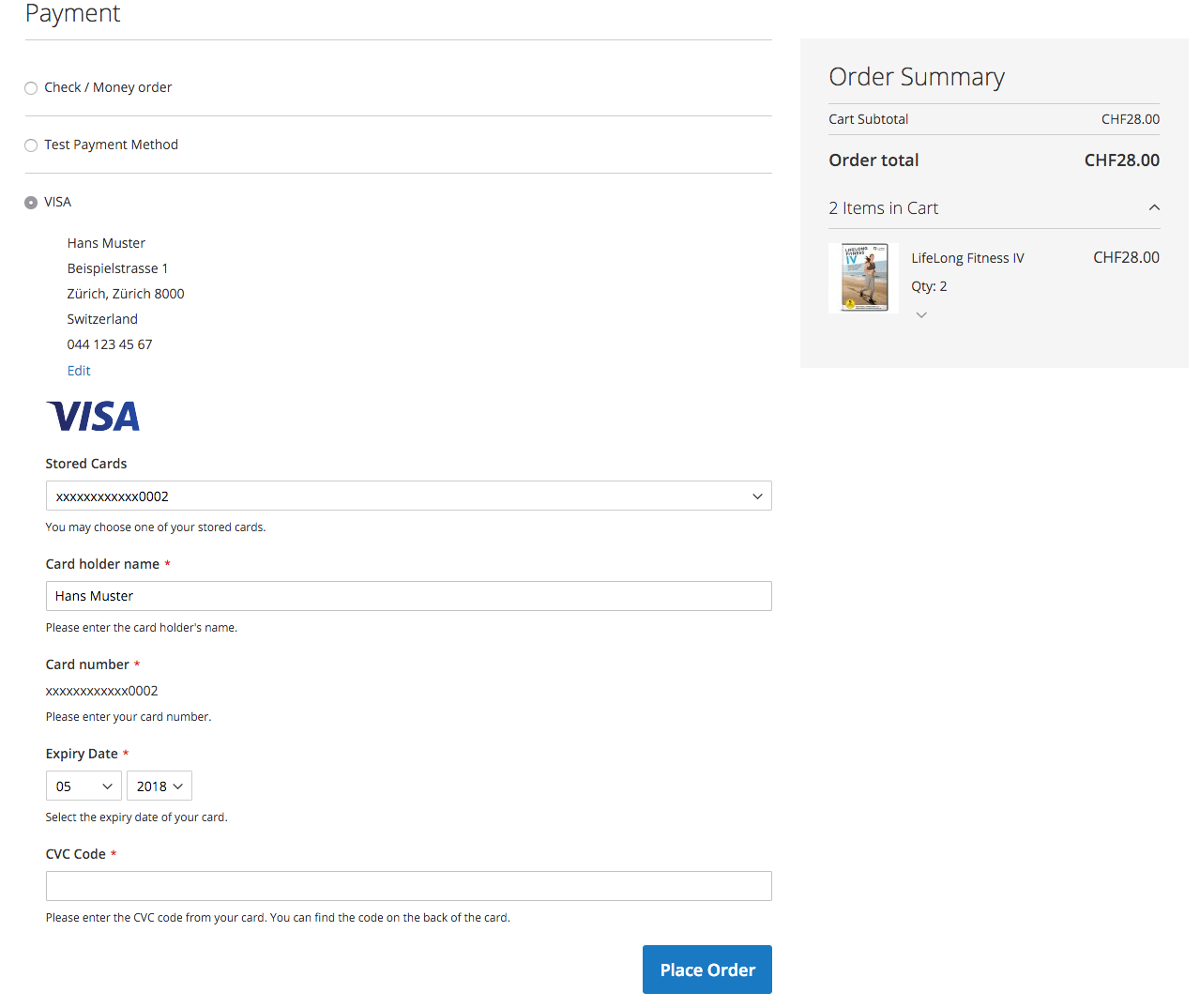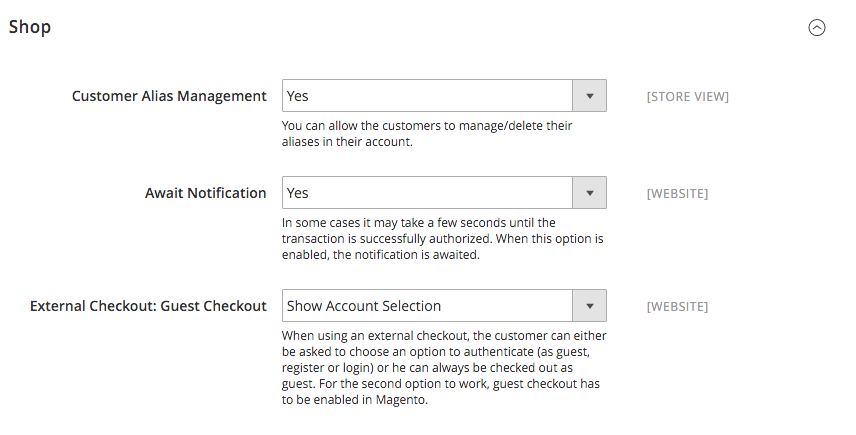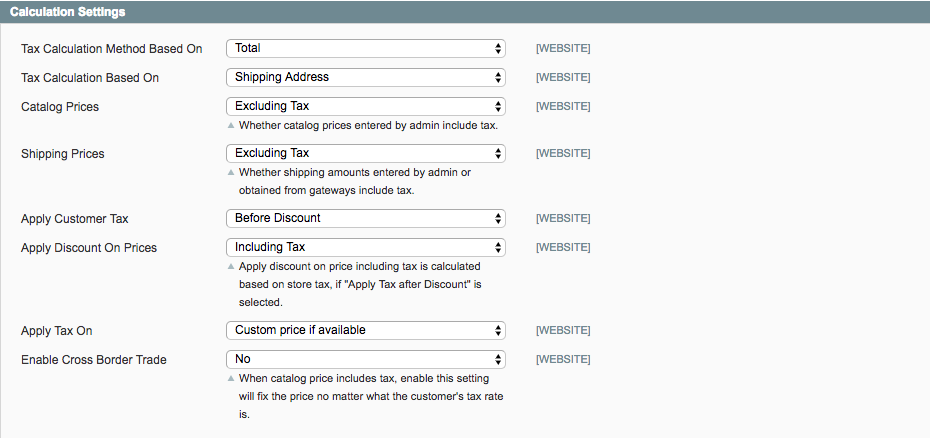1Introduction
This manual explains the installation, configuration and usage of the payment module for Magento and Computop.
Before beginning with the installation, please make sure that you are in possession of all necessary data:
- You should have received a Merchant ID from Computop for the test account. Furthermore, you have received the corresponding user name and password
- Encryption password and HMAC-Key
- An Analytics Password which you require for logging into Computop Analytics
- Magento payment module by sellxed.com/shop
- Access data to your server and shop
In case you don't yet have a contract with Computop, you can gladly acquire it directly through us.
Note that you must use at least PHP version 5.6 for our plugins. PHP 8 or higher is currently not supported.
1.1Process of the Installation
In this document you will find all important information for the installation of the module. It is important that you strictly follow the checklist. Only by doing so, can a secure usage in correspondence with all security regulations be guaranteed.
- Basic configuration of the server including the setting up of the notify script
- Configuration of the basic settings of the payment module
- Configuration of the payment methods
- Carrying out of a test purchase with the attached test data at the end of this document
- If the test was successful, your account can be activated
Our payment plugins should have per default the correct settings for most of our customers' preferences. That means once you have entered the required credentials in the plugin configuration to connect your account to your website, the plugin should be fully operational. Should you be willing to receive detailed information on a setting you do not know, you may contact our support team who will be able to assist you further.
Our support team is at your disposal during regular business hours at: http://www.sellxed.com/support. Furthermore, you have the option of ordering our installation service. We will make sure the plugin is installed correctly in your shop: http://www.sellxed.com/shop/de/integration-und-installation.html
In order to test the module, any kind of directory protection or IP blocking on your server must be deactivated. This is crucial as otherwise the payment feedback of Computop might not get through to the shop.
1.2System Requirements
In general, the plugin has the same system requirements as Magento. Below you can find the most important requirements of the plugin:- PHP Version: 5.4.x or higher
- Magento: 1.7.x or higher
- OpenSSL: Current version with support for TLS 1.2 or higher.
- fsockopen: The PHP function fsockopen must be enabled. The plugin must be able to connect to external systems over the Internet.
- PHP Functions: All common PHP functions must be enabled.
2Configuration of the Payment Module and the Server
In order to perform the configuration of the main module of Magento, the following information is necessary. You should have received the information from Computop.
- Computop Live Merchant ID
- Computop Live Encryption Key
- Computop Live Signature Passphrase
Enter the credentials directly inside the configuration of the main module. After you performed some test payments, you can switch between Live Mode and Test Mode.
2.1Configuration of the Payment Module
For the usage of the gateway in your shop, fill in all received access data at its corresponding place in the main module and in the payment methods.
Please Note if you use hidden this poses additional PCI requirements to your shop that have to be met. Get in touch with Computop to get additional information.
Also if you use Hidden in your Module please advise Computop that they are able to configure your paynow settings accordingly.
3Module Installation and Update in the Magento Shop
3.1Installation
At this time you should already be in possession of the module. Should this not be the case, you can download the necessary files in your customer account in the sellxed shop (Menu "My Downloads Downloads"). In order to install the module in your shop, please carry out the following steps:
- Download the plugin. The download can be found in your sellxed.com account under "My Downloads".
- Unzip the archive you have just downloaded.
- In the unzipped folder navigate to the folder "files"
- For some shops there are different versions of the plugin provided. If this is the case open the folder which corresponds to your shop version.
- Using your preferred FTP client upload entire content of this folder into the root directory of your shop. For some shops there is a specific folder containing the plugins. If that is the case upload the plugin into this folder. Make sure that the folders aren't replaced but merely merged.
- If you haven't yet done so, log back into your shop.
In the following you will find the installation manual for Magento 1 as well as Magento 2
3.1.1Magento 1
Before you start the installation or after doing an update of the module, please make sure, that the compiler cache is disabled. Also make sure that you cleared the cache otherwise it could be that the settings page is not visible.
- Create a back-up of your shop.
- Extract the content of the ZIP file.
- Copy the entire content of the folder "files" into the main directory of the server of your shop respectively to the folder where the plugins are copied normally. In order to do so, use your usual ftp program. Make sure that the folders aren't replaced but merely merged.
3.1.2Magento 2
Im Folgenden werden die Schritte für die Installation und das Update der Extensions erklärt.
3.1.2.1Installations Requirements
Bitte beachten Sie, folgende Voraussetzungen sind für den Betrieb von Magento 2 zwingend zu erfüllen:
- System requirements von Magento (http://devdocs.magento.com/guides/v2.0/install-gde/system-requirements.html)
- Der Cron Job muss korrekt eingerichtet sein, sonst können keine Extensions installiert werden. Weitere informationen fidnen Sie hier: http://devdocs.magento.com/guides/v2.0/config-guide/cli/config-cli-subcommands-cron.html
3.1.2.2Installation
For the installation of the plugin in your Magento 2 store please follow these steps:
-
Readiness Check
Before uploading the plugin it is necessary to do the Readiness Check for Magento 2
- 1. Save this script as cw-setup.php on your copmuter.
- 2. Upload this cw-setup.php Script into the root directory of your Magnto 2 installation.
- 3. Access your server via SSH and run this command: php cw-setup.php
- 4. The script will present you with additional commands which you need to execute.
About the cw-setup.php script
The provided script generates a set of commands which should be executed to clean up Magento 2. The script itself doesn't execute anything. It only generates the necessary commands.
-
Upload
Upload the content of the folder files_2 into the root directory of your server. Execute the commands provided by the cw-setup.php script again.
3.2Updates and Upgrades
You have direct and unlimited access to updates and upgrades during the duration of your support contract. In order to receive constant information about available updates we ask you to subscribe to our RSS feed that we publish for your module.
More information regarding the subscription of this RSS feed can be found under: http://www.sellxed.com/en/updates_upgrades.
We only recommend an update if something doesn't work in your shop, if you want to use new feature or if there is a necessary security update.
3.2.1Update Checklist
We ask you to strictly comply with the checklist below when doing an update:
- Always do a backup for your database and your files in your shop
- Use always a test system to test the update process.
- Wait until all the files are copied to the shop, clear the cache if there is one in your shop and then visit the configuration page of the main module so that the update process will be initialized.
Please test the update procedure first in your test shop. Our support team is able and willing to help you if you experience problems with the update process. However, if you decide to perform the update directly in your live shop there is the possibility of a downtime of the shop of more than two days depending on the availability of our support if you do not want to book our complementary support.
Depending on the version it could be that the database has to be migrated. We recommend you therefore, to perform the updates in times when the shop is not visited too frequently by your customers.
3.2.2Update Instructions
Please always read the update instruction. Those instructions can be found in the changelog. If there are no special remarks, you can proceed by just overwriting the files in your system.
3.2.2.1Magento 1
- Download the newest version of the plugin. The download is available in your sellxed.com account under "My Downloads".
- Extract the ZIP file.
- Upload the folder files_1into the root directory of your shop.
- Clear the Magento cache
3.2.2.2Magento 2
- Download the newest version of the plugin. The download is available in your sellxed.com account under "My Downloads".
- Extract the ZIP file.
- Upload the folder files_2into the root directory of your shop.
- Clear the Magento cache
3.3Database Migration
This section describes how you can run the database migration script
This only needs to be done if your Magento installation shows error messages regarding missing tables or columns in the database.
3.3.1Magento 1
Clear the Magento cache
If this does not resolve the issue, remove the entry computopcw_setup from the core_resource table and clear the cache again.
3.3.2Magento 2
From the command line run the following command:
php bin/magento setup:upgrade
4Module Configuration in the Magento Shop
The configuration consists of two steps. The first step is the configuration of the main module with all the basic settings (cf. Configuration of the Main Module). During the second step you can then carry out individual configurations for each payment method . This allows for full flexibility and perfect adaptation to your processes.
Please create a backup of the main directory of your shop. In case of problems you will then always be able to return your shop to its original state.
We furthermore recommend testing the integration on a test system. Complications may arise with third party modules installed by you. In case of questions, our support is gladly at your disposal.
4.1Configuration of the Main Module
4.1.1Magento 1
The settings for the main module can be found under System > Configuration > Computop. Enter the various options, some of which you have already specified in the configuration with Computop. Information on the functionalities as well as the impact of the individual settings can be found directly by the option.
The field "Time-Out for pending Payments" defines after how many minutes the order status should switch from pending to cancelled (0 means that nothing should be changed) if no successful feedback concerning the payment is received from Computop. This might occur e.g. if the customer has closed his or her browser. Further information on this topic can be found under Order Status.
4.1.2Magento 2
You will find the settings of the main module via Stores > Configuration > Sales > Computop > General.
Fill in the fields according to the configuration of Computop or with the data which you received directly from Computop. You can find more exact explanations regarding each option in the help text by the input boxes.

4.2Configuration of the Payment Method
4.2.1Magento 1
After having successfully installed the main module, you will find the individual payment modules under System > Configuration > Payment Methods. You can save individual settings for each payment method and thereby optimally adapt the payment methods to your existing processes. The most central options are described in more detail further below.
4.2.1.1Direct Capturing of Invoices
The "Invoice Creation" specifies if invoices should be captured directly or not. Captured invoices can no longer be modified. If you wish to be able to modify the ordered article for debiting, please set this option to "Deferred".
4.2.2Magento 2
After having successfully configured the main module, you will find the settings for each payment method in your shop via Stores > Sales > Payment Methods. For each payment method you can change the settings individually to optimize the payment processing in your shop.
4.2.2.1Accounting
For each payment method you need to choose whether you want to register directly or delayed. A delayed booking only reserves the amount. Therefore it is important that you follow the instructions for such transactions as listed below. Reservations are usually only valid for a few days so we recommend to register directly. The delayed booking isn't available for every payment method.
4.2.2.2Authorization Method
For some payment methods you can choose between different authorization methods. The authorization method determines how the payment form is presented in your shop. Please note that for some authorization methods with credit cards there are extended PCI requirements. (https://www.sellxed.com/en/blog/pci-300-changes).
4.3Direct Capturing of Transactions
The option "Capture" allows you to specify if you wish to debit payments directly or if you first wish to authorise them and then debit the payment at a later point.
Depending on your acquiring contract, a reservation is only guaranteed for a specific period of time. Should you fail to debit the payment within that period, the authorisation may therefore no longer be guaranteed. Further information on this process can be found below.
It may be that settings saved in the payment modules overwrite settings saved in Computop.
4.4Uncertain Status
You can specifically label orders for which the money is not guaranteed to be received. This allows you to manually control the order before shipment.
4.4.1Setting the order state
For each payment method you may select in which state the order should be set to depending on the booking state. This is the initial state of the order.
4.5Optional: Validation
Note: It can be that this option is not visible in your module. In this case just ignore this section.
With the option 'Validation' you can define the moment when the payment method should be made visible to the customer during the checkout process. This setting is relevant for modules where the usage depends on the customer's compliance with specific preconditions. For example, if a solvency check has to be carried out or if the payment method is only available in certain countries. In order for the credit check or address validation to also work with European characters, the charset of the "Blowfish mode" must be set to "UTF-8" for certain PSP settings.
You have the choice between these options:
- Validation before the selection of the payment method: A validation verification is carried out before the customer selects the payment method. If the customer does not fulfill the requirements, the payment method is not displayed
- Validation after selection of the payment method: The verification of the compliance occurs after the selection of the payment method and before the confirmation of the order
- During the authorisation: The validation verification is carried out by Computop during the authorisation process. The payment method is displayed in any case
4.5.1Usage of the Integrated Multishop Functionality of Magento
The payment module supports the multishop feature of Magento. No further modifications are necessary. The module automatically recognises the shop the order belongs to. In order for the multishop functionality to work, it is, however, necessary that the individual sub-shops within Magento have been configured correctly.
5Settings / Configuration of Payment Methods
5.1General Information About the Payment Methods
The plugin contains the most common payment methods. In case a desired payment method is not included per default, please contact us directly.
In order to be able to use a payment method, it must be activated in your account with Computop as well as in your shop. Information about the configuration of the payment methods can be found further above.
Below you can find important information for specific payment methods that deviate from the standard process.
5.2Information on Payment Status
For each payment method you can define an initial payment status (status for authorized payments etc.). You hereby define the payment status for each state depending on the processing type of the order (captured, authorized, etc.). It's the initial status which the order assumes. Depending on the mutation carried out by you, the status can change.
Never set the status to Pending Computop or any similar pending status which is implemented by the module.
5.2.1Order status "pending" / imminent payment (or similar)
Orders with the status 'pending Computop' are pending orders. Orders are set to that status if a customer is redirected in order to pay but hasn't returned successfully or the feedback hasn't reached your shop yet (Customer closed window on the payment page and didn't complete payment). Depending on the payment method these orders will automatically be transformed into cancelled orders and the inventory will be cleared (so long as the Cronjob is activated). How long this takes depends on the characteristics of the payment method and cannot be configured.
If you have a lot of pending orders it usually means that the notifications from your webserver to Computop are being blocked. In this case check the settings of your firewall and ask the Hoster to activate the IPs and User Agents of Computop.
5.2.2Order status "cancelled"
Orders with the status "cancelled" have either been set to that status automatically due to a timeout, as described above, or have been cancelled directly by the customer.
5.3Payment Methods
The modules differentiate between the standard and the professional version. In the professional version, all payment methods available for Computop are integrated. With the standard version, however, you only receive the most common payment methods. Should a desired payment method not be available, please contact us directly.
5.4MasterPass Integration: What to keep in mind
If you integrate MasterPass as a payment method in your shop, you have two integration options: External and Standard Checkout. When using External Checkout, the customer does not have to provide address data during checkout. The customer only needs a MasterPass account and the data will be transmitted by MasterPass. In order to use this option as a merchant, you have to activate this payment method with Computop.
Please keep in mind, that using additional functions such as address transmission through MasterPass, may require the activation of the respective options through Computop aktiviert.
In order to use MasterPass in compliance with the MasterCard guidelines, please read the following information carefully before using this payment method.
5.4.1Integration Possibilities for MasterPass
MasterPass can be integrated as a normal payment method with redirection to Computop or as an external checkout.
5.4.1.1MasterPass as a Payment Method
If you like to integrate MasterPass as a normal payment method, activate the payment method as usual (seeConfiguration of the payment method). In this scenario the customer will first be redirected to MasterPass and then to the wallet of the issuer.
5.4.1.2MasterPass as External Checkout
If you integrate MasterPass as an external Chekout, you can minimize the steps towards the payment radically. The adress transfer and the creation of the account is processed via MasterPass. If you activate the external checkout, there appears a button in the basket with which you can jump after the login directly to the last step of the order confirmation. The creation of the account happens in the background.
For the activation of the external checkout go to System > Computop for Magento 1 and under Stores > Computop for Magento 2 . There you'll find all settings for the external checkout:
MasterPass as external checkout is not for all cases available. If this point in the manual doesn't appear, please make sure to contact us.
5.4.2Checkout: MasterPass Learn More Button
When using MasterPass as a payment method for standard checkout, it is mandatory to link to the MasterPass Learn More Page. In order to do this, navigate to Payment Method Configuration. Paste the link for the Learn More Page into the field 'Description' for the respective languages. The field 'Learn More' will now be displayed when choosing a payment method.
We have already collected the most important links for you. You only have to copy and paste the links into the description field:
- German:<a href="https://www.mastercard.com/mc_us/wallet/learnmore/de/DE/" target="_blank">Mehr Erfahren </a>
- French:<a href="https://www.mastercard.com/mc_us/wallet/learnmore/fr/FR/" target="_blank">apprendre plus </a>
- English: <a href="https://www.mastercard.com/mc_us/wallet/learnmore/en/DE/" target="_blank">Learn More </a>
- Spanish:<a href="https://www.mastercard.com/mc_us/wallet/learnmore/en/ES/" target="_blank">aprender más </a>
- Italian:<a href="https://www.mastercard.com/mc_us/wallet/learnmore/it/IT/" target="_blank">saperne di più </a>
- Dutch:<a href="https://www.mastercard.com/mc_us/wallet/learnmore/nl/NL/" target="_blank">Leer Meer </a>

Links for additional languages can be found in this document: https://developer.mastercard.com/...
5.4.3Additional information
General and additional information on using the MasterPass trademark and logo in your webshop are available in the official MasterPass Mechant Branding Requirement Document. which you can access here: https://developer.mastercard.com/...
6The Module in Action
Below you will find an overview of the most important features in the daily usage of the Computop module.
6.1Capturing / Cancelling of Orders
6.1.1Magento 1
The transaction management between your shop and Computop is not synchronised. If you capture payments with Computop, the status in the shop will not be updated and a second capturing in the shop is not possible.
6.1.1.1Case 1: Invoice Capturing Directly After the Order
In the following, the process is explained for the case that you have chosen to directly create the invoice after having placed the order and only authorise payments - not capture them directly - (further information on the configuration can be found under Creating the Invoice).
In order to capture the order, open the invoice and click "capture". If you click "Cancel", the authorisation will be cancelled.
6.1.1.2Case 2: Deferred Invoice Capturing
In case you have chosen the deferred invoice creation, you first have to create the invoice by clicking on the button "Invoice". Select "Capture online" below the total amount and then click on "capture invoice". The invoice has now been captured.
6.1.1.3Cancel of orders/transactions
In order to cancel a transaction you first have to open the invoice and click on the cancel button. After that open the order and click on cancel here again. This will send the cancel of the order to Computop. Please note that you need to cancel the invoice and the order.
6.1.2Magento 2
6.1.2.1Capture Bug in Magento (v. 2.0.0)
In version 2.0.0 of Magento there is a bug. It could be that invoices cannot be captured. Please make the following adjustments in the file /vendor/magento/module-sales/Controller/Adminhtml/Order/Invoice/Capture.php:
- Delete the lines in the picture bellow which begin with a - .
- Add the lines which has been marked with a + .
Here you can find the codes to be inserted in the form of a text:
+ )->addComment( __('The credit memo has been created automatically.') );
6.1.2.2Performing Captures
The transaction management between Computop and your shop isn't synchronized. When you capture the payments at Computop , the status is not adjusted and a second capture isn't possible in your shop.
In the configuration of the payment method you can decide whether the invoice should be captured after having been created or if only the payment is authorized. You also decide if you already want to create an invoice. If you create an invoice you can't make any adjustments for the capture.
In order to capture invoices please take the following steps:
- Open the order and create an invoice.
- If you have set the Invoice Settlement to deferred you can still make adjustments to the invoice.
- Click on Capture Online.
6.1.2.3Cancelling / Voiding Orders
In order to issue a cancellation of the payment you must use the "Void" button. If you wish to use the "Cancel" button you must cancel the payment in the Computop backend portal.
6.2Place Orders in the backend of Magento
6.2.1Magneto 1
With the Magento payment module you can place orders and capture the payment directly in the shop; so called Mail Order / Telephone Order (MOTO).
- Go to the order overview and click on "Create New Order"
- The usual window for the creation of orders will be opened. Select the customer in question, the item and the address
- Select the preferred payment method and click on "Submit Order".
- Depending on the authorisation method that you have saved for the selected payment method, you will either be redirected to the Payment Page of Computop or the mask for the credit card will appear such as in the image below. Enter the credit card data of the customer.
6.2.2Magento 2
With the Magento payment module you can trigger orders directly from your shop, so called Mail Order / Telephone Order (MOTO).
- Go to the overview of the order (Sales > Orders) and click on "Create New Order"at the top right.
- The familiar window to create an order will open. Choose the desired customer, article and address.
- In the payment method box, choose the desired payment method and click on "Finalize order".
- After that you will be redirected either to the Payment Page of Computop or you will be asked to enter your payment information in the shop, depending on your settings.
If an alias of the customer exists, you can alternatively use that for the order.
6.3Refunds
6.3.1Magento 1
You can refund already captured transactions and automatically transmit them to Computop. In order to do so, open the invoice of the captured order. By clicking on "Credit Memo" the window for refunds is opened. Enter the amount you wish to refund. By clicking on "Refund" the refund is transmitted to Computop.
Below you find a step-by-step guide including screenshots:

6.3.1.1Refunds Based on Quantity
You can make refunds based on product quantity. In order to do so, open the credit memo window and enter the amount of products you wish to refund to your customer's card
You can carry out as many individual refunds as you wish until you have reached the quantity of the original order. The status of the order then automatically switches to complete.
6.3.1.2Refunding of Any Amount
As each position of the order needs to be transmitted to Computop we can't support the function Adjustment Refund - meaning the refund of any amount. Only whole items can be refunded by adjusting the refund amount.
It is possible to carry out several refunds on an order. Please note that you can refund a maximum of 100% of the original amount. If you have already carried out a refund you need to make sure not to refund more than the initial amount by adjusting the amount and the Adjustment Fee.
6.3.2Magento 2
6.3.2.1Resolving a Current Magento Bug (v. 2.0.0)
In the 2.x version of Magento there is a bug. Please make the following adjustments to the file /vendor/magento/module-sales/Model/Order/Payment.php :
- Delete the lines in the picture bellow which begin with a - .
- Add the lines which has been marked with a + .
Here you can find the codes to be inserted in the form of a text:
+ )->addComment( __('The credit memo has been created automatically.') );
6.3.2.2Performing Credits
For registered transactions you can create credits and transmit them automatically to Computop . In order to do so open an invoice of an already registered order. By clicking on "Credit Memo" a dialog will open for the refunds. Now you can adjust the number of products which you would like to credit in the credit memo dialogue.
Here you can find each step again including screenshots:
It is possible to issue several credits on one order. Please note that you can't credit more than 100% of the original amount. If you have already issued a credit you will need to make sure you don't credit more than the original amount, by adjusting the amount and the Adjustment Fee.
6.4Useful Transaction Information on the Order
6.4.1Magento 1
In each order, processed via our module, you can find an overview of the most important information about the transaction as well as a transaction history.
6.4.2Magento 2
In each order, which was processed by our module, you will find an overview of the most important information on the transaction and transaction history.
6.5Using Invoice Details of a Processor
6.5.1Magento 1
In the following context you can view or embed the "payment details" of for example an "Open Invoice" transaction:
6.5.1.1Magento Order Confirmation (E-Mail)
The "payment information" will be visible in the default "order confirmation e-mail" of Magento.
6.5.1.2Magento Invoice (PDF)
The "payment information" will be visible in the default Magento-Invoice.
6.5.1.3Magento-Backend (Transaction details)
You can view the payment and transaction details in Magento under Sales > Orders.
6.5.1.4Magento Success-Page
Due to technical limitations, it is currently not possible to display the "payment information" here.
6.5.2Magento 2
In the following context you can view or embed the "payment details" of for example an "Open Invoice" transaction:
6.5.2.1Magento Order Confirmation (E-Mail)
The "payment information" will be visible in the default "order confirmation e-mail" of Magento.
6.5.2.2Magento Invoice (PDF)
The "payment information" will be visible in the default Magento-Invoice.
6.5.2.3Magento-Backend (Transaction details)
You can view the payment and transaction details in Magento under Sales > Orders.
6.5.2.4Magento Success-Page
Due to technical limitations, it is currently not possible to display the "payment information" here.
6.6Usage of the Alias Managers / Token Solution
6.6.1Magento 1
With the Alias Manager, your customers can securely save their credit cards with Computop for later purchases. You can enable this by activating the option "Alias Manager" in the configuration of the Payment Method. The customer can then choose from their saved credit cards without having to enter all the details again.
To use the Alias Manager tit may be necessary to activate certain options in your Computop account. Please contact Computop directly to do so.
6.6.1.1Deleting Customer Aliases
You can easily delete a customer's alias by opening the customer in the backend of Magento. Switch to the tab Computop Alias and delete the saved alias directly here.
6.6.2Magento 2
Due to the integration of the Alias Manager the customers credit card data can be saved for later purchases. The customer can choose between the cards that have already been saved and won't have to enter all of credit card data again.
6.6.2.1Activating the Alias Manager / Token
In order for you to be able to use this you will need activate the option "Alias Manager" in the payment methods.
6.6.2.2Customers Deleting the Token
In Magento 2 you can allow your customers to manage the aliases in their customer account at "My Computop Aliases / Token"". This feature can also be enabled in the settings of the payment method
6.7Tax Calculation Settings
6.7.1Magento 1
To ensure that the taxes are calculated correctly and transmitted correctly to a third party invoice provider inside Magento please make sure that you set the calculation settings in the menu under System > Configuration > Tax as showed in the screenshot below.
Please also make sure that inside the settings of your promotion in the tab "Actions" the discount is not applied to the shipping amount as Magento is not correctly transmitting the tax rate there.
6.8OneStepCheckout
6.8.1Magento 1
The checkout of Magento can be modified and reduced to one step. The so called OnePageCheckout. Our modules support the most important OnePageCheckout extensions. If you are thinking of using a OneStepCheckout extension in combination with our Computop Magento, please make sure that you are using one of the following:
- OneStepCheckout by www.onestepcheckout.com
- OneStepCheckout by Ahead Works
- LightCheckout by GoMage
- Firecheckout by Templates Master
6.8.2Magento 2
6.9Setup a Cron Job to Activate the Timed Operations
6.9.1Magento 1
To activate the timed operations of the plugin (e.g. update service, deleting pending orders, etc.) make sure that you set up the Magento Cron engine. Especially the update function allows you to automatically retrieve additional information or changes of your order directly via the API of Computop. Please note it could be that in order to use the update feature it may be necessary that Computop activates additional options in your account.
The module uses the standard cron engine of Magento. More information regarding the set up can be found here.
Here we suggest you use a Cron Engine like for example EasyCron. This allows you to open the file (URL) with an external service.
6.9.2Magento 2
The module uses the standard cron engine of Magento 2. More information regarding the set up can be found here.
6.10Magento 1 API Manual
Via API, our module provides plenty of information on a transaction. The following section describes which calls are possible and what information is provided.
6.10.1General Information on Using the API
General information on using the Magento SOAP API can be found here: http://www.magentocommerce.com/api/soap/introduction.html
6.10.2API Calls
This overview shows the API Versions and which API Calls they support.
6.10.2.1API V1
- $client->call($session, 'computopcw_transaction.list'); //List of all transactions
- $client->call($session, ‘computopcw_transaction.info', {transactionsId}); // Single Transaction
6.10.2.2API V2
- $client->computopcwTransactionList($session); //List of all transactions
- $client->computopcwTransactionInfo($session, {transactionsId}); //Single Transaction
6.10.2.3XML-RPC
- $client->call('call', array($session, 'computopcw_transaction.list')); //List of all transactions
- $client->call('call', array($session, 'computopcw_transaction.info', {transactionsId})); //Single Transaction
6.10.2.4REST
- $this->callApi(‘computopcw/transactions'); //List of all transactions
- $this->callApi('computopcw/transactions/{transactionsId}'); //Single Transaction
7Testing
Before switching from test to live mode it is important that you test the module extensively.
Do not forget to switch the operating mode from test to live after having successfully tested the module.
7.1Test Data
In the following section you can find the test data for the various payment methods:Card number 5555555555554444 Expiry Date 12/2023 CVC 123 | Mastercard |
Card number 4000012892688323 Expiry Date 12/2020 CVC 123 | Visa |
Card number 5555555555554444 Expiry Date 12/2023 CVC 123 | Mastercard |
Card number 4000012892688323 Expiry Date 12/2020 CVC 123 | Visa |
| Direct | |
Last Name Wischnewski First Name Hans-Jürgen Birtday 1973-12-27 Street Müllerstraße 137 Postcode 13353 City Berlin Country DE Phone 03018425165 | RatePay: B2C |
Company Name Imperium UG Sales Tax Number DE123456789 Last Name Descartes First Name René Birtday 1973-12-27 Street Odeonplatz 1 Postcode 80539 City München Country DE Phone 08945687541 | RatePay: B2B |
BIC BYLADEM1ROS IBAN DE36711500000009290701 | InterCard: Accepted |
Customer ID customer1 Company Must be empty Gender FEMALE Firstname Julia Lastname Tester Street Aalener Str. 57 Post Code 73492 City Rainau Country DE Phone 07361889969 E-Mail Birtday 1987-10-25 | Paymorrow: Accepted |
Customer ID customer1 Company Must be empty Gender FEMALE Firstname Test Lastname Tester Street Schwarzenbergstrasse 4 Post Code 96050 City Bamberg Country DE Phone +49(5664)000000 E-Mail Amount Beliebig Birthday 1987-10-25 | Paymorrow: PrepareOrder ACCEPTED ConfirmOrder DECLINED |
Customer ID customer1 Company Must be empty Gender FEMALE Firstname Test Lastname Tester Street Schwarzenbergstrasse 4 Post Code 96050 City Bamberg Country DE Phone +49(5664)111111 E-Mail Amount under €300 Birthday 1987-10-25 | Paymorrow: PrepareOrder ACCEPTED ConfirmOrder ACCEPTED |
Customer ID customer1 Company Must be empty Gender FEMALE Firstname Test Lastname Tester Street Schwarzenbergstrasse 4 Post Code 96050 City Bamberg Country DE Phone +49(5664)222222 E-Mail Amount Beliebig Birthday 1987-10-25 | Paymorrow: PrepareOrder DECLINED |
Customer ID customer1 Company Must be empty Gender FEMALE Firstname Julia Lastname Tester Street Aalener Str. 57 Post Code 73492 City Rainau Country DE Phone 07361889969 E-Mail Birtday 1987-10-25 | Paymorrow: Accepted |
Card number 4355084355084358 Expiry Date 12/2020 CVC 000 | Visa |
Procedure Use any valid German address. The first two attempts are
succesful. The third will fail.
| BillPay |
Company Must be empty Firstname Paul Lastname Positiv Street Teststr. 4 Post Code 49084 City Osnabrück Phone 095198009 | BillSAFE: Accepted |
Test Data http://developers.klarna.com/en/testing/invoice-and-account
| Klarna |
Last Name Wischnewski First Name Hans-Jürgen Birtday 1973-12-27 Street Müllerstraße 137 Postcode 13353 City Berlin Country DE Phone 03018425165 | RatePay: B2C |
Company Name Imperium UG Sales Tax Number DE123456789 Last Name Descartes First Name René Birtday 1973-12-27 Street Odeonplatz 1 Postcode 80539 City München Country DE Phone 08945687541 | RatePay: B2B |
7.2Testing - Computop Simulation Mode
Any kind of payment method can be tested with our modules. The "Operation Mode" corresponds to the simulation mode with Computop. Payments with a total of less than 10'000 EUR are always accepted.
8Errors and their Solutions
You can find detailed information under http://www.sellxed.com/en/faq. Should you not be able to solve your problem with the provided information, please contact us directly under: http://www.sellxed.com/en/support
8.1Module is not shown
If the module is not shown even though the files have been downloaded onto the server correctly, please check the following:
- The local.xml can be found in the /app/etc directory
- Make sure disable_local_modules is set to ‚false‘
8.2The Referrer URL appears in my Analytics Tool
When a customer and the notification are redirected via Header Redirection, the Computop Referrer URL might appear in your Analytics Tool thus hiding the original traffic source. However, most Analytic Tools are able to minimize this problem.
In case you are using Google Analytics as reporting tool, this step by step guide may help you to exclude the URLs: under bullet point 4.
9Compatibility with Third-Party Plugins
The plugins listed below are compatible with our payment modules and allow you to handle certain tasks in a easier way.
9.1Magento 1
9.1.1Fees and discounts within Magento
To configure a Computop payment gateway based fee and discount, you will need the following 3rd-Party plugin.
9.2Birthday and gender in Magento 1
For certain payment service providers it is necessary to check the birthday an the gender of a customer. Magento 1 does not check this by default. this check can be enabled under "Go to System > Configuration | Customers > Customer Configuration > Name and Address Options".
9.3Birthday and gender in Magento 2
For certain payment service providers it is necessary to check the birthday an the gender of a customer. Magento 2 does not check this by default. this check can be enabled under "Stores > Configuration | Customers > Customer Configuration > Name and Address Options".
10Error Logging
The module will log different unexpected errors or information depending on the configured level. If there is any issue with the module, this log can help identify the cause.
10.1Log Levels
You can configure the log level in the Computop settings. The store log setting does not affect these log messages.
- Error: Logs unexpected errors only. (Default)
- Info: Logs extended information.
- Debug: Logs information helpful for debugging.
10.2Log Location
The log file is stored in the Magento log directory. (Default Path: {shopRootDirectory}/var/log)
11Advanced Information
This section of the manual is for advanced usage of the module. The content is for advanced users with special requirements. Everything in this section is optional and not required for the daily usage of the module.
11.1Transaction Object
This section describes how to extract information from a transaction, if you need it for further processing. E.g. you require more information of the transaction for further processing an order in your ERP system.
The code snippets in this section assume your script resides in the root folder of the shop with the default shop folder structure.
11.1.1Magento 1
define('MAGENTO_ROOT', getcwd());
$mageFilename = MAGENTO_ROOT . '/app/Mage.php';
require_once $mageFilename;
Mage::setIsDeveloperMode(true);
ini_set('display_errors', 1);
umask(0);
Mage::app();
$dbtransaction = Mage::getModel('computopcw/transaction')->load($transactionId);
$transactionObject = $dbtransaction->getTransactionObject();
$dbtransaction = Mage::getModel('computopcw/transaction')->load($orderId,'transaction_external_id');
$transactionObject = $dbtransaction->getTransactionObject();
11.1.2Magento 2
use Magento\Framework\App\Bootstrap;
require __DIR__ . '/app/bootstrap.php';
$bootstrap = Bootstrap::create(BP, $_SERVER);
$obj = $bootstrap->getObjectManager();
$state = $obj->get('Magento\Framework\App\State');
$state->setAreaCode('frontend');
$factory = $obj->get('Customweb\ComputopCw\Model\Authorization\TransactionFactory')->create();
$dbTransaction = $factory->load($transactionId, 'entity_id'); $transactionObject = $dbTransaction->getTransactionObject();
$dbTransaction = $factory->load($orderId, 'order_id'); $transactionObject = $dbTransaction->getTransactionObject();
$dbTransaction = $factory->load($paymentId, 'payment_id'); $transactionObject = $dbTransaction->getTransactionObject();




